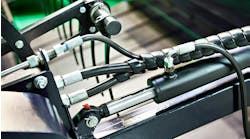How many different types of hydraulic oil are taking up space in your oil store? If there's more than one you're not alone. I often get questions from members who'd like to consolidate their hydraulic oil inventory but aren't sure how to go about it. This one is typical:
"We have a number of pieces of hydraulic equipment e.g., bucket trucks, cranes, backhoe, rollback wrecker, dump trucks, scissors lifts, etc. It seems like each piece of hydraulic equipment requires a different hydraulic oil. I'd like to know the compatibility or interchangeability of the different products before I do irreversible harm. I'm confused by all the different hydraulic oil we're currently using. For example, Warren R&O, Conoco MV-22, NAPA AW-46, AW-315, etc. Is there a primer on oil; a guide that tells me what goes where?" --Bob Bauman.
The first step is to decipher all the different abbreviations and numbers to understand what you've got, so you can compare 'apples to apples'. This task is complicated by the different standards used. And some abbreviations and numbers used by individual manufacturers aren't standard at all. So looking at Bob's array of oils:
R&O or RO stands for rust and oxidation - hydraulic oils with improved anti-rust and anti-oxidation properties. The ISO classification for these oils is HL. AW stands for anti-wear. These are RO hydraulic oils with an anti-wear additive package. The ISO classification for these oils is HM.
MV stands for multi-viscosity. To the best of my knowledge, this is not a standard abbreviation. In theory MG (multi-grade), MW (multi-weight) or HVI (high viscosity index) could all be used to mean the same thing. Regardless, these oils contain viscosity index improvers which modify the rate of change in viscosity with temperature. The ISO classification is HR for VI improved RO oils and HV for VI improved AW oils.
Now to the numbers. 22, 46 and 315 refer to the viscosity grade (VG) of the hydraulic oil. 22 and 46 are ISO standard grades and the numbers refer to the oil's kinematic viscosity in centistokes at 40 degrees Celsius - plus or minus 10 percent. So an ISO VG46 oil has a viscosity of between 41.4 and 50.6 centistokes at 40C. 315 is a now mostly obsolete ASTM viscosity number - 315 SUS at 100 degrees Fahrenheit, which is roughly equivalent to ISO VG68.
As you can now see, Bob has both RO and AW hydraulic oil in three different viscosity grades - one of which is high VI. On the surface, my hunch would be that a single oil - probably AW-46, could cover his entire fleet. But to confirm this, each piece of hydraulic equipment needs to be assessed individually. The detailed procedure for doing this is explained in The Hydraulic Maintenance Handbook.
Once this has been done and the appropriate type and grade of hydraulic oil chosen, the next issue to consider is how to go about changing equipment over to the standardized oil. The first thing to understand is you ain't going to get any peace of mind from the oil companies. It's highly unlikely that any oil blender will tell you it's OK to mix their oil with a competitors. And for good reason too. When oils with different additive chemistry are mixed, there is always a risk of additive 'drop-out'.
At the very least, you should be doing a thorough oil drain and filter change as part of switching oils. But unless it's practical or possible to drain every part of the system, a small percentage of the original hydraulic oil will remain and be mixed with the new oil.
So before making the switch, it's a good idea to mix equal parts of the original and new oil in a glass jar and shake vigorously. Wait half an hour and observe the solution. Look for changes in color, clarity, viscosity and sediment. If in doubt, or for extra peace of mind, filter 100 milliliters of the old, new and mixed oils through a patch filter - noting the time taken for each. If nothing abnormal is observed, then it should be safe to proceed.
Be aware that mixing hydraulic oils without taking these simple precautions can be a costly mistake. And to discover six other costly mistakes you want to be sure to avoid with your hydraulic equipment, get "Six Costly Mistakes Most Hydraulics Users Make... And How You Can Avoid Them!" available for FREE download here.
Sponsored Recommendations
May 15, 2024
March 13, 2024
March 13, 2024
March 13, 2024

